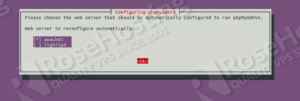

Follow these steps to use Apache's built-in features to restrict access and secure phpMyAdmin directories. Secure phpMyAdmin on Ubuntuīeing easy to use – and free – makes phpMyAdmin a target for hackers. The browser loads the phpMyAdmin dashboard. Enter the username and password you created. Open up a browser window and enter localhost, your server’s IP address or domain name, followed by /phpMyAdmin: localhost/phpMyAdmin 192.168.0.1/phpMyAdmin The browser displays a screen welcoming you to phpMyAdmin, with a login field. Once the operation completes, exit the MySQL shell by entering: exit Step 6: Test phpMyAdmin This changes terminal prompt to show mysql>, indicating that you’re logged into the MySQL shell.Įnter the following commands, replacing UserNamewith a username of your choice, and PassWordwith a strong password of your choice: CREATE USER IDENTIFIED BY 'PassWord' GRANT ALL PRIVILEGES ON *.* TO WITH GRANT OPTION Log in to the MySQL server as follows: sudo mysql However, a simpler method to avoid auth_socket is to create a new administrator account for MySQL. It is possible to change the authentication type. However, this makes using phpMyAdmin difficult. This compares the socket username against the name specified in the MySQL user table and is a tightly-secured authentication method. Restart the Apache service to refresh the changes by entering the following in a terminal: sudo systemctl restart apache2 Step 5: Create a New MySQL Administrator Accountīy default, MySQL 5.7 and later in Ubuntu, authenticate a root user using auth_socket. Press Enter and allow the process to finish.
PHPMYADMIN UBUNTU SETUP PDF
pdf files to work correctly, but it's not enabled by default.Įnter the following in your terminal to enable mbstring: sudo phpenmod mbstring Select apache2 (use spacebar to choose), press Tab to navigate to and hit Enter. Shortly the installation starts, the installer prompts to choose the web server to automatically configure. The system asks for confirmation – press Y then Enter, and the system downloads and installs the phpMyAdmin software package.

PHPMYADMIN UBUNTU SETUP INSTALL
To install phpMyAdmin, enter the command: sudo apt-get install phpmyadmin
PHPMYADMIN UBUNTU SETUP UPDATE
Once completed, refresh the software lists by entering the following commands: sudo apt-get update & sudo apt-get upgradeĪllow the operation to finish.

If not, the system asks for your password – enter it, then make sure the process completes successfully. If the repository is already enabled, skip to the next step. To add them, open a terminal window and enter the following command: sudo add-apt-repository universe Some Ubuntu 18.04 installations are not configured with the software repositories for phpMyAdmin. Installing phpMyAdmin on Ubuntu Step 1: Add and Update Software Repositories Also, since phpMyAdmin is a popular application, it’s a common vector for attacks. A plain HTTP connection is unencrypted and can be intercepted. Note: If you’re connecting to a remote server, there’s a security risk in running phpMyAdmin over plain HTTP.


 0 kommentar(er)
0 kommentar(er)
